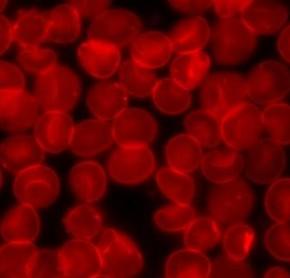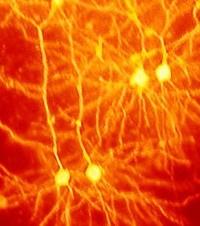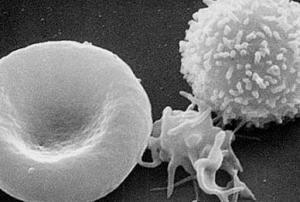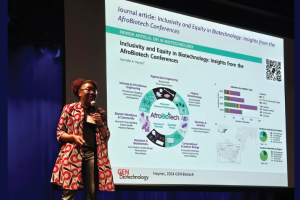 This post is presented by SBE, the Society for Biological Engineering--a global organization of leading engineers and scientists dedicated to advancing the integration of biology with engineering.
This post is presented by SBE, the Society for Biological Engineering--a global organization of leading engineers and scientists dedicated to advancing the integration of biology with engineering.

According to a study published in the journal
Nature, stem cell researcher
Mick Bhatia and his colleagues at
McMaster University in Hamilton, Canada, have turned human skin cells directly into blood cells for the first time--without first passing through a middle, stem-cell-like state.

Their breakthrough follows other recent studies showing that mouse skin, bathed in the right chemicals, could be converted directly into
neurons and
heart muscle.
First attempt with a human cell
This was the first attempt to use human cells to create blood progenitor cells. Dr. Bhatai and his
lab 
team, which painstakingly developed the technique over two years, chose skin cells to make blood
progenitors (the cells that multiply, producing other blood cells) because stem cell derived blood cells do not make adult hemoglobin. "Those cells, because they think they're embryonic, make embryonic and fetal blood," he says.
Through trial and error, Bhatai found that by infecting the cells with a virus that inserted the gene
OCT4, and after growing the treated cells in a solution of
cytokines--a protein that signals genes to turn on--the skin cells could be reprogrammed into the desired progenitor cells.
Bhatia's team also found that the cells' gene-expression patterns never resembled embryonic stem cells, and the blood progenitor cells didn't cause lab mice to develop tumors characteristic of pluripotent cells.
Successful outcomes and the "sweet spot"

But the progenitors did produce all three classes of blood cells: red, white and platelets--and the red blood cells made adult hemoglobin, not the fetal form. Dr Bhatia and his team also found the "sweet spot" where the cells would convert skin to blood in a matter of a months, and even create multiple blood types.
Bhatia told
CTV in Toronto that even he was surprised when he saw his first blood cell:
"I didn't believe it. I thought it was another cell type masquerading as blood cells," he recalls.
Unfortunately, transplanting the cells into humans won't happen soon. Converted cells, unlike embryonic stem cells, cannot easily multiply, so producing large quantities for transfusions and drug screening is still extremely difficult. "The clinical side is going to be a lot of work," says Bhatai.
Many potential treatments
But the potential is enormous. Cancer patients, who often withdraw from chemotherapy once the treatment starts to destroy the blood system, could continue without a break. The genetic mutation in the blood that causes leukemia isn't found in the skin. So skin cell converted blood would be healthy.
For Dr. Bhatia, a therapy that's a product of a patient's own on body will be very powerful. Someday the agonizing wait for a matching bone marrow donor may be over. "Will it work? Well, that's what we're going to find out."
To see
Dr Bhatia on CTV click here and play videos.
Photo: Red blood cells: DougM - Wikimedia
Photo: Mouse neurons: Neurollero- Wikimedia
Photo: Mick Bhatia; McMaster Press release
Photo: Red and white blood cells - Wikipedia
Related articles
 This post is presented by SBE, the Society for Biological Engineering--a global organization of leading engineers and scientists dedicated to advancing the integration of biology with engineering.
This post is presented by SBE, the Society for Biological Engineering--a global organization of leading engineers and scientists dedicated to advancing the integration of biology with engineering.
 According to a study published in the journal Nature, stem cell researcher Mick Bhatia and his colleagues at McMaster University in Hamilton, Canada, have turned human skin cells directly into blood cells for the first time--without first passing through a middle, stem-cell-like state.
According to a study published in the journal Nature, stem cell researcher Mick Bhatia and his colleagues at McMaster University in Hamilton, Canada, have turned human skin cells directly into blood cells for the first time--without first passing through a middle, stem-cell-like state.
 Their breakthrough follows other recent studies showing that mouse skin, bathed in the right chemicals, could be converted directly into neurons and heart muscle.
Their breakthrough follows other recent studies showing that mouse skin, bathed in the right chemicals, could be converted directly into neurons and heart muscle.
 team, which painstakingly developed the technique over two years, chose skin cells to make blood progenitors (the cells that multiply, producing other blood cells) because stem cell derived blood cells do not make adult hemoglobin. "Those cells, because they think they're embryonic, make embryonic and fetal blood," he says.
Through trial and error, Bhatai found that by infecting the cells with a virus that inserted the gene OCT4, and after growing the treated cells in a solution of cytokines--a protein that signals genes to turn on--the skin cells could be reprogrammed into the desired progenitor cells.
Bhatia's team also found that the cells' gene-expression patterns never resembled embryonic stem cells, and the blood progenitor cells didn't cause lab mice to develop tumors characteristic of pluripotent cells.
team, which painstakingly developed the technique over two years, chose skin cells to make blood progenitors (the cells that multiply, producing other blood cells) because stem cell derived blood cells do not make adult hemoglobin. "Those cells, because they think they're embryonic, make embryonic and fetal blood," he says.
Through trial and error, Bhatai found that by infecting the cells with a virus that inserted the gene OCT4, and after growing the treated cells in a solution of cytokines--a protein that signals genes to turn on--the skin cells could be reprogrammed into the desired progenitor cells.
Bhatia's team also found that the cells' gene-expression patterns never resembled embryonic stem cells, and the blood progenitor cells didn't cause lab mice to develop tumors characteristic of pluripotent cells.
 But the progenitors did produce all three classes of blood cells: red, white and platelets--and the red blood cells made adult hemoglobin, not the fetal form. Dr Bhatia and his team also found the "sweet spot" where the cells would convert skin to blood in a matter of a months, and even create multiple blood types.
Bhatia told CTV in Toronto that even he was surprised when he saw his first blood cell:
But the progenitors did produce all three classes of blood cells: red, white and platelets--and the red blood cells made adult hemoglobin, not the fetal form. Dr Bhatia and his team also found the "sweet spot" where the cells would convert skin to blood in a matter of a months, and even create multiple blood types.
Bhatia told CTV in Toronto that even he was surprised when he saw his first blood cell:





